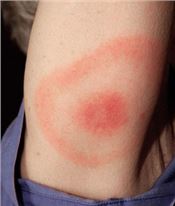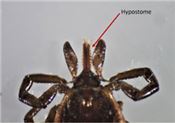|
Blacklegged Ticks Keep On Ticking Regardless Of Winter
DR. JONATHAN LARSON AND ANNA PASTEMAK
LEXINGTON, KY.
When people think of ticks, they often think of them as a spring or summertime problem. This is the case for two of our common Kentucky ticks, the lone star tick and the American dog tick. Adults of these species are most common between April and August, with nymphal and larval stages popping up as well. These two species of tick can be important vectors of spotted fever rickettsia (American dog tick) and the Alpha-Gal red meat allergy (Lone star tick).
The most famous tick though, tends to be the blacklegged deer tick, also known as just the deer tick. This species is noteworthy as they are the only vector for Lyme disease in the eastern half of the United States. Blacklegged ticks like to feed on their favorite host, the white tail deer, but are more than happy to also slurp up some blood from a human. Unlike their aforementioned cousins, adults of this species are most common from October to May and will be out and about on any day above freezing. This winter has been particularly mild, so they have likely been out and about enjoying the balmy days of February.
Lyme Disease & the Blacklegged Tick
Cases of Lyme disease and other tick-borne diseases in the United States are increasing each year – they are also increasing in Kentucky. Lyme is very common in the north-eastern region of the United States, but in recent years doctors have seen more cases in the mid- and south-eastern states as well. Scientists believe this is because blacklegged tick populations are growing. The Center for Disease Control (CDC) cites that Lyme disease affected an estimated 450,000 people in 2018, a 1,400 percent increase from the number of cases seen in 2003. In people, Lyme disease symptoms include fever, fatigue, joint pain and a rash that appears in a bullseye pattern at the site of the bite (Figure 2). This disease also infects dogs and can cause lameness, joint pain, and fever. Proper removal of the tick and early treatment for illness are the most important steps you can take if an infection takes place.
Blacklegged Tick Facts
Blacklegged ticks are found anywhere that deer may roam. They “quest” at the tips of branches or on plants that deer would be likely to rub up against. When they get on humans, they will seek out a thin-skinned area where they can plug in their mouthparts. Ticks must drink blood in order to develop through their life cycle and females need blood to produce eggs as well. The mouths of ticks have backward facing spines and they can produce a natural “cement” to help anchor them in place (Figure 3).
Tick Removal
If you find a tick feeding on you, you need to safely remove it as soon as possible. There are many “remedies” you can find for removing ticks on the internet, but the most basic advice is best. Use a pair of tweezers to grab the tick as close to your skin as possible and firmly pull the tick straight up. Do not wiggle the tick out, do not twist it around; just one swift pull upwards from the skin. You must also avoid treating the tick with essential oils, alcohol, or fire while it is still “plugged in” to you. You will drive the tick off with these kinds of products, but you will also increase the chance the tick “vomits” into you, possibly transferring any pathogens that may be inside of them.
Because the Lone star and American dog ticks are active during spring and summer and Blacklegged ticks are active through winter, it’s smart to protect yourself from ticks whenever you spend time outside in areas where ticks may live. Using repellants for your skin (such as DEET or picaridin) can help but treating your clothing with permethrin will provide the best protection. Permethrin is not to be used on the skin and should only be applied to clothing items. Everyone should also be performing routine tick checks after spending time in tick habitat to hopefully intercept ticks before they bite. Treating your pets with tick preventive medicine will keep them tick-free and help to prevent them from accidentally bringing the little bloodsuckers into your yard and house. ∆
DR. JONATHAN LARSON: Extension Entomologist, University of Kentucky
ANNA PASTEMAK: Entomology Graduate Student, University of Kentucky

Figure 1: The three most common types of ticks that may affect people in Kentucky are the blacklegged tick, American dog tick, and Lonestar tick.
The adults can be active at different times of the year and may be encountered in various habitats.
Photos: Anna Pasternak, UK Entomology

Figure 2: A bullseye patterned rash is common in patients who have acquired the pathogen responsible for Lyme disease.
Photo: Center for Disease Control

Figure 3: When ticks feed, they insert a hypostome into their host. This mouthpart has many backward facing spines
and can make it difficult to remove the tick!
|
|